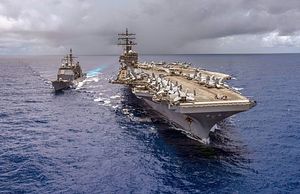The U.S. Navy has assembled a team to look at what the next generation of large surface warships will look like. At Defense News, David Larter reports on the opening of the “large surface combatant requirements evaluation team,” which will look at cruiser replacement options at the behest of Rear Admiral Ron Boxhall.
Boxhall suggested that the new cruiser may look somewhat like an upsized Arleigh Burke-class destroyer, possibly with some elements borrowed from the Zumwalt-class destroyer. This would result in a ship similar in size to China’s latest destroyers, but considerably smaller than the CG(X) type cruiser proposed in the early 2000s. Requirements above and beyond the Flight III DDG-51s appear to include improved power generation capacity, a larger missile magazine, the ability to launch and recover UAVs, and a relatively open architecture which will enable economical, long-term upgrades.
This is not the first time that the Navy has probed the idea of building large surface combatants. The 25000 ton CG(X) cruiser, proposed in 2001, foundered in part because of changing mission needs (ballistic missile defense became a thing) and in part because of the extravagant defense outlays of the Wars on Terror. The 30,000 ton “arsenal ship,” discussed in the 1990s, ran aground on some communities within the Navy, as well as the post-Cold War drawdown. The 18,000 ton “Strike Cruiser” of the 1970s was sunk, in part, by the return of the Iowa class battleships.
But the Ticonderogas are growing old, and there is no ready replacement in the wings. More importantly, after several decades technology has shifted to the advantage of large surface combatants, as demands on power generation, missile magazines, and sensors have combined to push up requirements for space. The PLAN’s Type 055 class destroyers are a harbinger of change in this regard, as are the South Korean Sejong the Greats. The concept of “distributed lethality” also calls for large vessels capable of both self-defense and offensive action. The next surface combatant will have a lot to do, and will need the size and energy generation capacity to do all of it. The only question is whether the US procurement system can handle the problem.
Boxhall suggests that the first vessels could be ordered by 2024. If literally everything goes well, this could result in the lead ships entering service in 2028 or 2029, which would still require the Navy to extend the lifespans of the remaining Ticonderoga-class cruisers. In any case, the U.S. Navy is in crunch time with respect to its cruiser fleet; it needs do something productive in the near term in order to maintain fleet cohesion.
The views expressed here are his personal views and do not necessarily reflect those of the Department of Defense, the U.S. Army, the Army War College, or any other department or agency of the U.S. government.
































